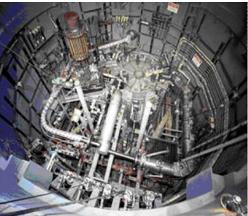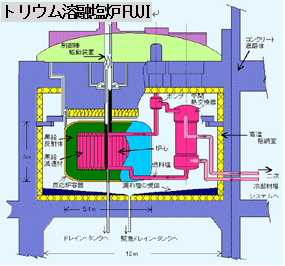New Nuclear
Proposal for Realization of Molten Salt Liquid Fuel Reactor
The door to a new nuclear age is about to open
The Paris Agreement, adopted at the 21st Conference of the Parties to the United Nations Framework Convention on Climate Change (COP21) in 2015, accelerated the trend towards the realization of a low-carbon society that prevents global warming by further reducing fossil fuel consumption. rice field.
We believe that nuclear energy is an excellent energy source created by human wisdom and holds the key to realizing a low-carbon society.
However, in order for nuclear power to become an energy source that truly contributes to humankind, four problems must be solved: safety, power generation costs, radioactive waste, and the proliferation of nuclear weapons. Dr. Kazuo Furukawa, the first president of our company, showed that the thorium molten salt reactor can solve all these problems in his book “Nuclear Safety Revolution” (Bunshun Shinsho 2011/05 publication).
In November 2015, the Nuclear Innovation Acceleration Gateway (GAIN) project was launched in the United States as a form of nuclear innovation. METI and the Ministry of Education, Culture, Sports, Science and Technology have jointly launched the Nuclear Innovation Promotion (NEXIP) Initiative for nuclear research and development, including the development of innovative reactors.
In addition, the U.S. Department of Energy (DOE) decided to provide $6 million in support for the first year of a joint industry-academia-government team to develop a molten salt furnace. is coming.
TTS is the only company in Japan that has been directly involved in the development of molten salt furnaces. lead the

Why has the molten salt reactor now emerged as the favorite of the future reactor?
(Part 1) Safety in principle
There are three conditions for ensuring the safety of nuclear reactors: (1) reliable shutdown of the reactor in an emergency, (2) removal of decay heat released from nuclear materials, and (3) prevention of radioactive material outflow. It’s one. A liquid fuel nuclear reactor is equipped with a drain tank (exhaust container) with a cooling function directly below the core. In an emergency such as a large-scale earthquake or tsunami, the nuclear reaction immediately stops when the liquid fuel is discharged from the reactor core into an underground drain tank. The liquid fuel in the drain tank is cooled without power supply, and the decay heat is removed and solidified. Even if the reactor is damaged, radioactive materials will not flow outside. After the emergency is lifted, the solidified fuel will be melted and returned to the reactor.
(Part 2) Low power generation cost
The basis for calculating the power generation cost of about 5 yen/kWh for a 200,000 kWe molten salt reactor is an estimate of the impact of miniaturization based on a paper on the conceptual design of a molten salt breeder reactor (MSBR) in the United States. The amount is within the range of standard figures published by molten salt furnace ventures around the world. On the other hand, the calculation basis for the power generation cost of about 6 yen/kWh for ultra-small reactors is the result of rough cost calculation based on the conceptual design results based on the reference design example. Although we have not announced the details at this time, the total cost of operating a molten salt furnace with a lifespan of 30 years for three generations in the same building, with an initial cost of approximately 18 billion yen and an annual running cost of approximately 500 million yen. is divided by the total power generation.
(Part 3) Ease of spent nuclear fuel processing
Another issue for nuclear power is the disposal of spent fuel. Reprocessing of solid fuel starts with pulverization of spent fuel, dissolution with nitric acid, and various complex chemical processes to form solid fuel again. On the other hand, since liquid spent fuel is originally liquid, it does not require dissolution treatment and can be reprocessed as it is, which greatly shortens and simplifies the treatment process. Furthermore, by using molten salt liquid fuel, the volume of minor actinides (MA), which is the most dangerous long-lived high-level radioactive waste, can be reduced to about 1/1000 of the current volume.
(Part 4) The road to the abolition of nuclear weapons
Molten-salt reactors fueled by thorium do not produce the plutonium needed to make nuclear weapons, so there is no danger that the possessing nations will become nuclear-armed. Therefore, it can be constructed all over the world with peace of mind. In addition, since it uses liquid fuel, it is the only reactor that is currently conceivable that can eliminate plutonium by using plutonium instead of thorium.
(1)緊急時の炉の確実な停止
(2)核物質から放出される崩壊熱の除去
(3)放射性物質の外部流出の防止
の三つです。液体燃料原子炉は炉心直下に冷却機能を備えたドレンタンクを備えます。大規模地震発生や津波襲来等の緊急時に、液体燃料を炉心から地下ドレンタンクへ排出すると、核反応は直ちに停止します。ドレンタンク内の液体燃料は無電源で冷却され、崩壊熱が除去されると共に凝固します。万一原子炉が破損しても放射性物質は外部に流出しません。凝固した燃料は緊急事態解除後溶解して原子炉に戻します。
History of molten salt liquid fuel reactor
|
In the early days of nuclear power development, the United States considered solid fuels as well as liquid fuels. The most famous molten salt liquid-fuel reactor is the thorium molten salt experimental reactor MSRE, which was built in 1965 under the leadership of Dr. Alvin Weinberg, former director of the Oak Ridge National Laboratory in the United States (Fig. 1). Four years of continuous accident-free operation was successful, and the basic technology required for a molten salt liquid fuel reactor was established. However, in 1976, research and development was discontinued due to the fact that the technical bases for solid and liquid fuels were different, and that the thorium molten salt reactor was of no military value because thorium does not produce plutonium. Meanwhile, in Japan, Dr. Kazuo Furukawa continued research and development of thorium molten salt reactors and completed the design of 10,000 kW small reactor mini FUJI and 200,000 kW standard reactor FUJI as Japan’s unique thorium molten salt reactors. In order to realize these goals, we established our company, TTS. Dr. Kazuo Furukawa passed away on December 14, 2011, but TTS continues his research and development efforts. |

|
|
Figure 1. Thorium Molten Salt Experimental Reactor MSRE constructed in the United States in 1965 under the initiative of Dr. Alvin Weinberg |
Global trends in molten salt furnace development: A new trend is emerging
In recent years, molten salt liquid fuel reactors have been re-evaluated around the world due to their safety in principle and the ease of processing spent nuclear fuel. In 2011, full-scale research and development of molten salt furnaces began in China, starting with molten salt cooling furnaces. Molten-salt furnaces are also positioned as an important component of the Obama administration’s clean energy strategy in the United States. , Oak Ridge National Laboratory, Electric Power Research Institute (EPRI), and Vanderbilt University (Tennessee) for an industry-academia-government collaborative R&D project with development costs of $6 million in the first year. The impact of the US government’s investment in the development of molten salt reactors has been significant, and it is believed that there will be a major global trend in the development of molten salt liquid fuel reactors in the future.
In October 2020, the U.S. Department of Energy (DOE), through its new Advanced Reactor Demonstration Program (ARDP), provided $160 million in initial funding to TerraPower and X-Energy to build a demonstration reactor expected to be operational within seven years. was awarded. Going forward, the DOE will invest a total of $3.2 billion over seven years, with industry partners providing matching funding, according to its available budget. In this way, the DOE and US industry regard nuclear energy as clean energy, and nuclear reactor development is important not only for the economy but also for the environment.
Development of Thorium Molten Salt Furnace
|
Uranium and thorium are the nuclear resources that exist on Earth. Since plutonium cannot be produced from thorium, thorium has been rarely used as fuel for nuclear reactors. However, minable thorium is hundreds of times more abundant than nuclear fuel uranium-235, making thorium a promising nuclear resource as an energy source in the atomic age for peace.
TTS is a thorium molten salt liquid fuel reactor that uses thorium as fuel. First, a 25,000 kW ultra-small commercial demonstration reactor was developed, followed by a 200,000 kW small commercial reactor (FUJI) (Fig. We aim to develop 2). The thorium molten salt reactor is safe, easy to dispose of nuclear waste, and does not produce plutonium that could lead to nuclear weapons. The core structure is also simple, and the conceptual design of the micro-reactor confirmed a power generation cost of about 6 yen/kWh. The main target small reactor (FUJI) is expected to be around 5 yen/kWh, and we aim to achieve 4 yen/kWh in the future. |

|
Thorium Molten Salt Reactor Leads the World to Peace
We believe that many global crises, such as international conflicts, are caused by the large economic disparity between wealth and poverty. One of the means to eliminate this disparity is the supply of low-cost energy. With low-cost energy, water can be produced in areas where desertification is progressing. In addition, if there is low-cost energy, it is possible to create industries in the area, and solve the problem of poverty.
A thorium molten salt reactor will enable low-cost energy supply to all regions of the world. Since the thorium molten salt reactor uses thorium as fuel, it does not produce plutonium, which could lead to nuclear weapons. Thorium Molten Salt Furnace Eliminates Poverty. And the Thorium Molten Salt Reactor will lead the world to peace.
